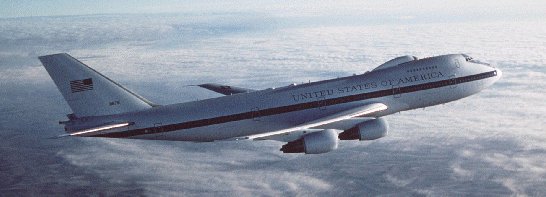The E-4B, a variant of the Boeing
747B airliner, is operated by the USAF as its AABNCP
(Advanced Airborne National Command Post). Its purpose is
to provide an aerial platform and command center for the
US leadership in the event of nuclear war. Dubbed the
'Doomsday Plane' in popular jargon, the aircraft is kept
in readiness to carry the President or others in the chain
of leadership known as the NCA (National Command
Authority), during the initial hours or days of a general
conflict. During an attack on US soil, some leaders would
be taken to an underground command post in Virginia while
others would go aboard the E-4B to direct American Forces.

Four E-4Bs are assigned to the 1st Airborne Command
& Control Squadron, part of the 55th Wing at Offutt
AFB, Nebraska. The practice of keeping a detachment with
one E-4B on alert at Andrews AFB, Maryland, a short
helicopter trip away from the White House, was
discontinued in the late 1980s.
The E-4B uses the size and bulk of the familiar 747B
airliner fuselage to accommodate the President (in his
role as Commander-in-Chief of US forces) and key members
of his battle staff on its 4,620 ft2 (429 m2)
main deck, partitioned into five operating compartments.
These are the flight crew section, NCA area (roughly a
flying equivalent of the White House Situation Room), a
conference room, battle staff area, and C3I
(command, control, communications and intelligence) area.
This main deck is 185 ft (56.4 m) in length, with a
maximum width of 19 ft 6 in (5.94 m). A second deck
provides a rest area for mission personnel.
This 'war readiness aircraft' is equipped with nuclear
thermal shielding, hardening against EMP (electromagnetic
pulse), LF/VLF (low frequency/very-low frequency) radios,
and extensive satellite communications equipment. Included
is equipment to tie into commercial telephone and radio
networks to broadcast emergency messages to the general
population. The current E-4B also has an SHF (super-high
frequency) system with antennas housed in a distinctive
dorsal blister. Every component of the aircraft, including
engines, avionics and wiring, has been optimized for
maximum flight duration.
On its awesome mission, the E-4B cruises typically at
580 mph (933 km/h), is refueled in flight, and meets a
requirement to be capable of staying aloft for 72 hours.
In actual war, even this duration could be extended to a
full week. Like the Presidential VC-25A, which is the
other Boeing 747 derivative in the inventory, the E-4B's
sustainability aloft is limited only by oil lubricant of
its engines. Power is provided by four 52,500-lb
(233.53-kN) thrust General Electric F103-PW-100
(CF6-50-E2) turbofan engines.
Today, the E-4 mission is identified as NEACP (National
Emergency Airborne Command Post), inevitably pronounced
'kneecap' by those who work on the aircraft.
The E-4 was developed to meet a requirement known as
481B for an airborne national command center. On 28
February 1973, a contract was awarded to Boeing for two E-4A
airframes, with a third following soon after. The E-4A
made its first flight without mission equipment on 13 June
1973. The sophisticated internal fit was added by
E-Systems and the first E-4A was delivered in late 1974.
The E-4B version, with improved accommodations,
upgraded engines and SHF system, commenced delivery of the
fourth airplane in the series on 21 December 1979. This
first E-4B entered service in December 1980, and the three
remaining aircraft were subsequently upgraded to E-4B
standard. Early plans for a total fleet of six aircraft
were eventually reduced to four.
Despite the thawing of the Cold War, the USAF is
expected to maintain its fleet of four E-4Bs
(73-1676/1677; 74-0787; 75-0125), which has accumulated an
impressive safety record in more than a decade of
operations.
MISSION PROFILE
Configuration Options: the E-4 is configured as
an AABNCP (Advanced Airborne National Command Post; its
upper deck serves as a crew rest area; the main deck holds
the President (as Commander-in-Chief of US Forces) and his
battle staff in five compartments: the flight crew
section, the NCA (National Command Authority) work area, a
conference room, battle staff and C3I (command,
control, communications and intelligence) area; the
aircraft is shielded against EMP.
Advanced Airborne National Command Post (AABNCP):
the E-4B cruises typically at 580 mph (933 km/h) at 32,000
ft (9754 m), is refuelled in flight, and meets a
requirement to stay aloft for 72 hours; in a nuclear war,
this duration could be extended to a full week. The E-4B's
sustainability aloft being limited only by oil lubricant
of its engines.
SPECIFICATIONS
Boeing E-4B
Wing: span 195 ft 8 in (59.64 m); aspect ratio
6.96; area 5,500.0 ft2 (510.95 m2)
Fuselage and tail: length 231 ft 4 in (70.51 m);
height 63 ft 5 in (19.33 m); tailplane span 72 ft 9 in
(22.17 m); wheel base 84 ft 0 in (25.60 m)
Powerplant: four General Electric F103-GE-100 rated
at 52,500 lb (233.53 kN) thrust
Weights: maximum take-off 800,000 lb (362874 kg)
Fuel and load: internal fuel 331,565 lb (150395 kg)
Speed: maximum level speed at 30,000 ft (9145 m)
602 mph (969 km/h)
Range: ferry range 7,830 miles (12600 km); mission
endurance without in-flight refueling 12 hours, and with
in-flight refueling 72 hours
Performance: cruise ceiling 45,000 ft (13,715 m);
take-off distance less than 10,820 ft (3298 m); landing
field length 6,920 ft (2109 m) at maximum weight
Inventory: 4
IOC: December 1980
CURRENT USAF OPERATOR
Air Combat Command
55th Wing 1st Airborne Command &
Control Squadron Offutt AFB, NE
E-4B